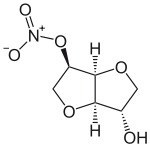- Isosorbide mononitrate
-
Isosorbide mononitrate 
Systematic (IUPAC) name 8-nitrooxy-2,6-dioxabicyclo[3.3.0]octan-4-ol Clinical data AHFS/Drugs.com Consumer Drug Information Pregnancy cat. C (USA) Legal status ? Routes Oral Pharmacokinetic data Bioavailability >95% Protein binding <5% Metabolism Hepatic Half-life 5 hours Excretion Renal: 93% Identifiers CAS number 16051-77-7 ATC code C01DA14 PubChem CID 27661 DrugBank APRD00528 ChemSpider 25736 
UNII LX1OH63030 
KEGG D00630 
ChEBI CHEBI:6062 
ChEMBL CHEMBL1311 
Chemical data Formula C6H9NO6 Mol. mass 191.139 g/mol SMILES eMolecules & PubChem  (what is this?) mononitrate (verify)
(what is this?) mononitrate (verify)Isosorbide mononitrate is a drug used principally in the treatment of angina pectoris[1] and acts by dilating the blood vessels so as to reduce the blood pressure. It is sold by AstraZeneca under the trade name Imdur, and marketed in the UK under the trade names: Monosorb, Chemydur. In India this drug is available under the brand names of Ismo, Monotrate, Solotrate, and Monit.
Contents
Uses
Isosorbide mononitrate is a nitrate-class drug used for the prophylactic treatment of angina pectoris; that is, it is taken in order to prevent or at least reduce the occurrence of angina. Research on isosorbide mononitrate as a cervical ripener to reduce time at hospital to birth is supportive.[2]
Side effects
The adverse reactions which follow have been reported in studies with isosorbide mononitrate:
Very common: Headache predominates (up to 30%) necessitating withdrawal of 2 to 3 % of patients, but the incidence reduces rapidly as treatment continues .
Common: Tiredness, sleep disturbances (6%) and gastrointestinal disturbances (6%) have been reported during clinical trials with isosorbide mononitrate modified release tablets, but at a frequency no greater than for placebo. Hypotension (4 to 5%), poor appetite (2.5%), nausea (1%).
Adverse effects associated with the clinical use of the drug are as expected with all nitrate preparations. They occur mainly in the early stages of treatment.
Hypotension (4%) with symptoms such as dizziness and nausea (1%) have been reported. These symptoms generally disappear during long-term treatment.
Other reactions that have been reported with isosorbide mononitrate modified release tablets include tachycardia, vomiting, diarrhoea, vertigo and heartburn.
Interactions
- Sildenafil (Viagra). Concomitant administration of isosorbide mononitrate and sildenafil (Viagra) can potentiate the vasodilatory effect of isosorbide mononitrate with the potential result of serious side effects such as syncope or myocardial infarction. Therefore, sildenafil should not be given to patients already receiving isosorbide mononitrate therapy.
- Sulfhydryl containing compounds. The metabolism of organic nitrates to nitric oxide is dependent on the presence of sulfhydryl groups in the muscle. The combination of oral N-acetylcysteine and a single dose of sustained release isosorbide mononitrate 60 mg significantly prolonged the total exercise time in patients with angina pectoris and angiographically proven significant coronary artery disease, when compared with isosorbide mononitrate alone. Concomitant administration of other exogenous sources of sulfhydryl groups such as methionine and captopril may produce a similar interaction.
- Phenylalkylamine calcium antagonists. The addition of a calcium channel blocker of the verapamil type, such as gallopamil 75 mg, has been shown to further improve left ventricular functional parameters when given in combination with isosorbide mononitrate in a sustained release formulation.
- Propranolol. The addition of isosorbide mononitrate to propranolol treatment in patients with cirrhosis and portal hypertension caused a marked fall in portal pressure, a reduction in hepatic blood flow, cardiac output and mean arterial blood pressure, but no additional change in azygos blood flow. The additional effect of isosorbide mononitrate was especially evident in patients whose portal pressure was not reduced by propranolol.
- Calcium antagonists (general). Marked symptomatic orthostatic hypotension has been reported when calcium antagonists and organic nitrates were used in combination. Dose adjustments of either class of agent may be necessary.
References
- ^ Imdur (isosorbide-5-mononitrate) is a nitrate preparation for angina pectoris, AstraZeneca Cardiovascular]
- ^ Shrikant Bollapragada, Fiona Mackenzie, John Norrie, Stavros Petrou, Margaret Reid, Ian Greer, Inass Osman and Jane E Norman (2006). "IMOP: randomised placebo controlled trial of outpatient cervical ripening with isosorbide mononitrate (IMN) prior to induction of labour – clinical trial with analyses of efficacy, cost effectiveness and acceptability". BMC Pregnancy and Childbirth 6: 25. doi:10.1186/1471-2393-6-25. PMC 1569865. PMID 16869966. http://www.biomedcentral.com/1471-2393/6/25.
External links
Vasodilators used in cardiac diseases (C01D) Nitrates/nitrovasodilators Glyceryl trinitrate # • Isosorbide dinitrate # • Isosorbide mononitrate • Linsidomine • Molsidomine • Pentaerythritol tetranitrateQuinolone vasodilators Others Itramin tosilate • Prenylamine • Oxyfedrine • Benziodarone • Carbocromen • Hexobendine • Etafenone • Heptaminol • Imolamine • Dilazep • Trapidil • Molsidomine • Efloxate • Cinepazet • Cloridarol • Nicorandil • Nesiritide • Gapicomine • PimobendanAstraZeneca Products Anastrozole · Atenolol · Brompheniramine · Budesonide · Disufenton sodium · Esomeprazole · FluMist · Gefitinib · Goserelin · Isosorbide mononitrate · Motavizumab · Omeprazole · Palivizumab · Propofol · Rosuvastatin · Tamoxifen · Ticagrelor · Vandetanib · Ximelagatran · ZolmitriptanPredecessors and
acquired companiesPeople Categories:- Alkyl nitrates
- Antianginals
- Furofurans
- Alcohols
- AstraZeneca
Wikimedia Foundation. 2010.
